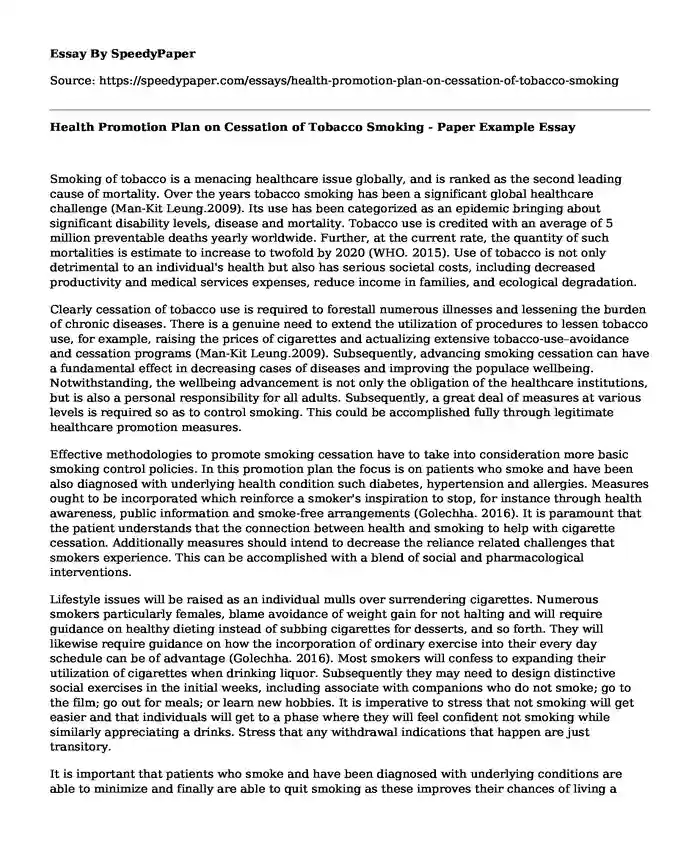
| Type of paper: | Essay |
| Categories: | Healthcare |
| Pages: | 3 |
| Wordcount: | 746 words |
Smoking of tobacco is a menacing healthcare issue globally, and is ranked as the second leading cause of mortality. Over the years tobacco smoking has been a significant global healthcare challenge (Man-Kit Leung.2009). Its use has been categorized as an epidemic bringing about significant disability levels, disease and mortality. Tobacco use is credited with an average of 5 million preventable deaths yearly worldwide. Further, at the current rate, the quantity of such mortalities is estimate to increase to twofold by 2020 (WHO. 2015). Use of tobacco is not only detrimental to an individual's health but also has serious societal costs, including decreased productivity and medical services expenses, reduce income in families, and ecological degradation.
Clearly cessation of tobacco use is required to forestall numerous illnesses and lessening the burden of chronic diseases. There is a genuine need to extend the utilization of procedures to lessen tobacco use, for example, raising the prices of cigarettes and actualizing extensive tobacco-use–avoidance and cessation programs (Man-Kit Leung.2009). Subsequently, advancing smoking cessation can have a fundamental effect in decreasing cases of diseases and improving the populace wellbeing. Notwithstanding, the wellbeing advancement is not only the obligation of the healthcare institutions, but is also a personal responsibility for all adults. Subsequently, a great deal of measures at various levels is required so as to control smoking. This could be accomplished fully through legitimate healthcare promotion measures.
Effective methodologies to promote smoking cessation have to take into consideration more basic smoking control policies. In this promotion plan the focus is on patients who smoke and have been also diagnosed with underlying health condition such diabetes, hypertension and allergies. Measures ought to be incorporated which reinforce a smoker's inspiration to stop, for instance through health awareness, public information and smoke-free arrangements (Golechha. 2016). It is paramount that the patient understands that the connection between health and smoking to help with cigarette cessation. Additionally measures should intend to decrease the reliance related challenges that smokers experience. This can be accomplished with a blend of social and pharmacological interventions.
Lifestyle issues will be raised as an individual mulls over surrendering cigarettes. Numerous smokers particularly females, blame avoidance of weight gain for not halting and will require guidance on healthy dieting instead of subbing cigarettes for desserts, and so forth. They will likewise require guidance on how the incorporation of ordinary exercise into their every day schedule can be of advantage (Golechha. 2016). Most smokers will confess to expanding their utilization of cigarettes when drinking liquor. Subsequently they may need to design distinctive social exercises in the initial weeks, including associate with companions who do not smoke; go to the film; go out for meals; or learn new hobbies. It is imperative to stress that not smoking will get easier and that individuals will get to a phase where they will feel confident not smoking while similarly appreciating a drinks. Stress that any withdrawal indications that happen are just transitory.
It is important that patients who smoke and have been diagnosed with underlying conditions are able to minimize and finally are able to quit smoking as these improves their chances of living a much healthier and disease free life. With the help of a health worker patients who endeavor to quit are able to come with various goals which help through the process of smoking cessation. Such goals include change in social behaviors to discourage smoking, use of nicotine patches wen necessary and routine health check-ups to track health bio-makers. Majority of techniques include the standards of inducing change at an individual level, an adjustment in accepted practices in the community and socio-political endeavors to advance the wellbeing of the populace (Spohr et al 2015). It would be productive powerful to execute the intercessions zeroing in on social attitudinal and ecological changes before attempting to focus in on individual behaviors change, which is daunting to achieve.
References
Golechha, M. (2016). Health promotion methods for smoking prevention and cessation: a comprehensive review of effectiveness and the way forward. International journal of preventive medicine.
Man-Kit Leung, C., Leung, A. K., Ellis Hon, K. L., & Yim-Fai Kong, A. (2009). Fighting tobacco smoking-a difficult but not impossible battle. International Journal of Environmental Research and Public Health, 6(1), 69-83.
Spohr, S. A., Nandy, R., Gandhiraj, D., Vemulapalli, A., Anne, S., & Walters, S. T. (2015). Efficacy of SMS text message interventions for smoking cessation: a meta-analysis. Journal of Substance Abuse Treatment.
World Health Organization. (WHO) (2015). WHO report on the global tobacco epidemic 2015: raising taxes on tobacco. World Health Organization.
Cite this page
Health Promotion Plan on Cessation of Tobacco Smoking - Paper Example. (2023, Dec 28). Retrieved from https://speedypaper.com/essays/health-promotion-plan-on-cessation-of-tobacco-smoking
Request Removal
If you are the original author of this essay and no longer wish to have it published on the SpeedyPaper website, please click below to request its removal:
- Free Essay Example on Post-Traumatic Disorder
- Free Essay: Wellness and Prevention Program to Prevent Falls in the Elderly
- Essay Sample: Utilizing Technology to Deliver Quality Universal Healthcare
- The Role of Registered Nurses in Healthcare Delivery in New Zealand - Paper Example
- Free Essay on Speech Topic: Incorporating SBAR tools in hospital communication.
- Doctor-Patient Relationships - Essay Sample
- Insights Across Issues: A Compilation of Essay Samples on COVID-19, Public Health, and More
Popular categories




